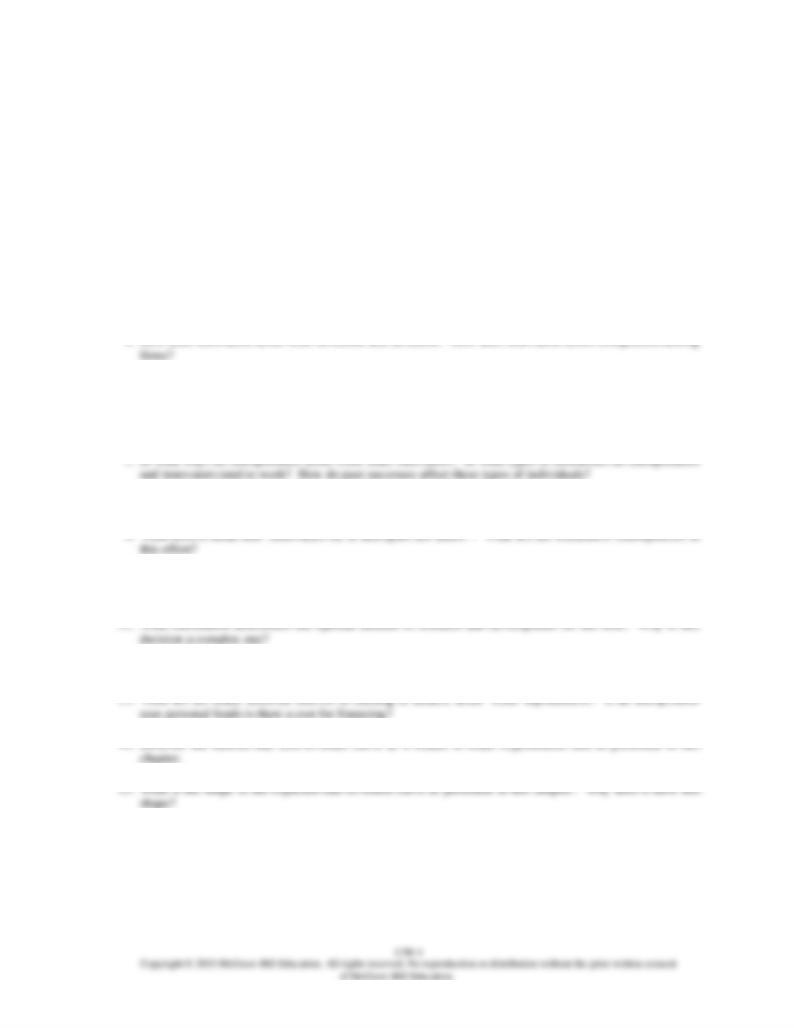
CHAPTER 13 Web
Technology, R&D, and Efficiency
Note: This bonus web chapter is available at the textbook Web site: www.mcconnell20e.com.
A. Short-Answer, Essays, and Problems
1. Give a definition of technological advance. What role does time play in the definition according to
economists?
2. What is the difference between the short run, long run and very long run?
3. Explain and give examples of invention. What does government do to protect it?
5. Describe R&D expenditures in the United States. What percentage of spending goes for invention,
innovation, and diffusion?
6. Compare and contrast the modern view of technological advance with the traditional view.
8. Is innovation within existing firms important? Explain and give examples.
10. Why do entrepreneurs and other innovators actively study the scientific output of universities and
government laboratories?
12. What ways do firms have to finance R&D activities? What is the cost of these forms of funding?
16. Explain how the firm decides on the optimal amount of research and development.
17. Why might many R&D expenditures be affordable, but not worthwhile? Are outcomes from R&D
guaranteed?

18. A firm decides to make a $10 million expenditure on research and development that will create a new
product. This product is expected to increase the firm’s revenues by a total of $12 million in the next year.
The firm also estimates that the production cost of the new product will be $11 million.
19. A firm decides to make a $15 million expenditure on research and development that will create a new
product. This product is expected to increase the firm’s revenues by a total of $20 million in the next year.
The firm also estimates that the production cost of the new product will be $18 million.
20.Use the table below that shows the rate of return and R&D spending for a hypothetical firm. Assume the
interest-rate cost of funds is 8%.
Expected rate
of return (%)
R&D
(millions of
$)
14
6
12
9
10
12
8
15
6
18
4
21
21. The initial values for expected returns, R&D and interest-rate cost for an energy company’s investment in
developing alternative fuels are listed in the table below. Using this information, answer the following
questions.
Expected rate
of return (%)
R&D
(millions)
Interest rate
cost of funds, %
40
$20
15
35
30
15
30
40
15
25
50
15
20
60
15
15
70
15
10
80
15
5
90
15
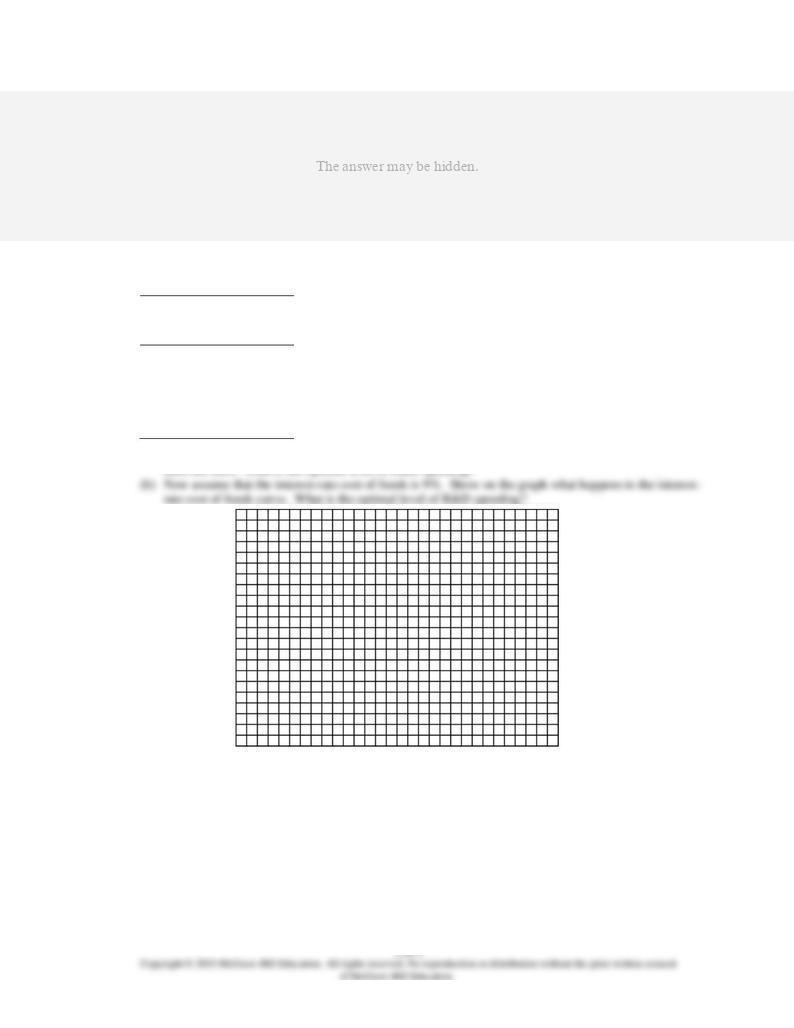
22. Use the table below that shows the rate of return and R&D spending for a hypothetical firm. Assume the
interest-rate cost of funds is 6%.
Expected rate
of return (%)
R&D
(millions of
$)
15
0
12
10
9
20
6
30
3
40
(a) Graph the marginal cost and marginal benefit curves of R&D spending in the graph below. Be sure to
23. Use the graph below to answer the following questions.
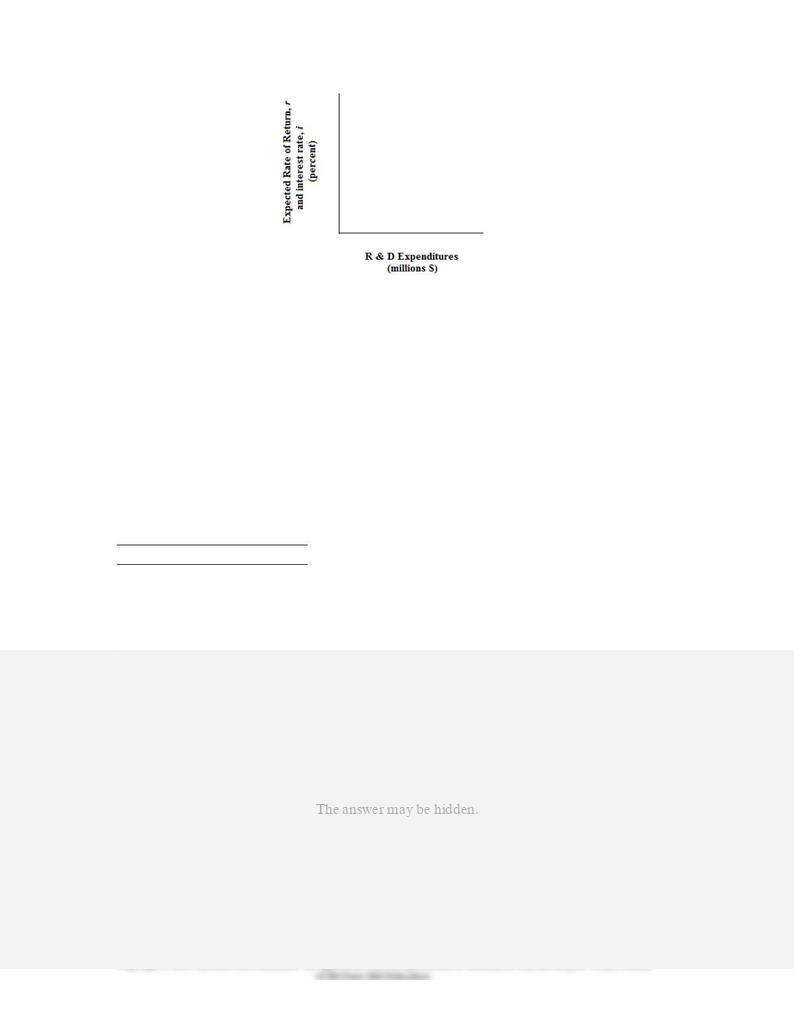
(a) Draw in a typical marginal cost and marginal benefit curve of R&D in the graph below. Suppose the
equilibrium interest rate is 5% and the R&D expenditures is 25 million.
(b) Graphically depict the effect of an increase in the interest rate from 5% to 7%. What happens to the
amount of R&D Expenditures?
24. Describe how a firm’s revenues and profits are increased through product innovation. What three other
points should be noted about these results?
25. A consumer makes purchases of an existing product A such that the marginal utility is 40 and the price is
$20. The consumer also tries a new product B and at the current level of consumption it has a marginal
utility of 72 and a price of $24. What does the utility-maximizing rule suggest that this consumer should
do?
26. The table below shows the marginal utility schedules for old product X and new product Y for a
hypothetical consumer. The price of X is $4 and the price of good Y is $2. The income of the consumer is
$20.
Product X
Product Y
Quantity
MUx
Quantity
MUy
1
32
1
28
2
28
2
24
3
24
3
20
4
20
4
16

27. The table below shows the marginal utility schedules for a soft drink and an energy drink. The price of the
soft drink is $2 and the price of the energy drink is $4. The consumer’s income is $10.
Soft Drink
Energy Drink
Quantity
MUs
Quantity
MUe
1
50
1
70
2
40
2
50
3
30
3
40
4
20
4
24
28. Explain how process innovation reduces cost and increases profits. How does this innovation affect the
firm’s total product curve and average cost curve?
29. Assume a firm faces these costs: total cost of capital = $4000; price paid for labor = $20 per labor unit; and
price paid for raw materials = $8 per raw-material unit.

31. Below are two average total cost schedules for a firm. The first schedule (ATC1) shows the cost of
producing the product at five levels of output before a new innovation. The second schedule (ATC2) shows
the average total cost at the five output levels after the innovation. What was the reduction in average total
cost at each of the five levels of output as a result of the innovation?
Output
Before
ATC1
After
ATC2
10
$38
$32
20
30
22
30
28
20
40
31
23
50
38
31
(a) What was the reduction in average total cost at each of the five levels of output as a result of the
32. What is the fast-second strategy? What are the risks to a dominant firm from using such a strategy?
33. What is the imitation problem resulting from technological advance? How might a dominant firm respond
to the threat from product innovation by a smaller firm?

34. Describe the legal protections and potential advantages of taking the lead in innovation.
35. (Consider This) What product did the Roman citizen Erasmo (c. 130 A.D.) produce and how did he maintain
his trade secret?
37. Compare and contrast the suitability of different market structure for fostering technological advance.
38. Explain the reasoning behind the inverted-U theory of R&D expenditures.
39. Explain the basic conclusions from inverted-U theory of R&D. What will be the optimal market structure
for technological progress? What does the evidence suggest about its validity?
41. How might innovation create or reduce monopoly power?
42. How can innovation foster creative destruction? What are the objections to that idea?
43. (Last Word) Evaluate this statement “We should reduce federal spending on research and development
today. Those federal dollars are better spent by helping the poor.”
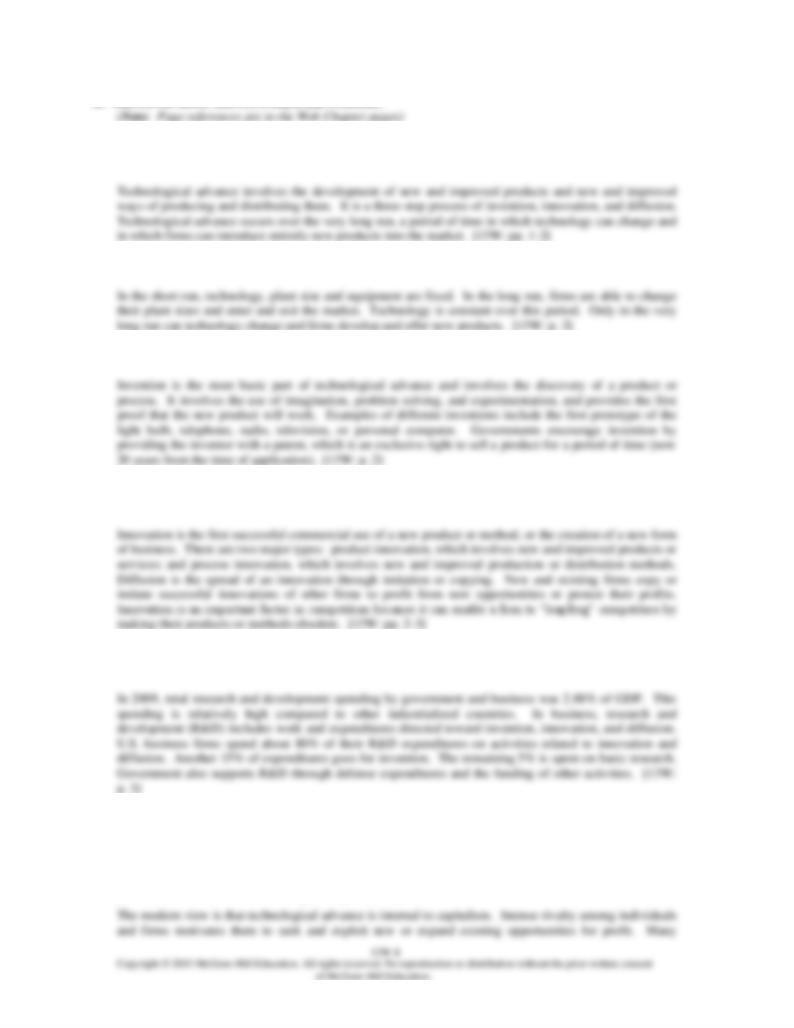
B. Answers to Short-Answer, Essays, and Problems
1. Give a definition of technological advance. What role does time play in the definition according to
economists?
2. What is the difference between the short run, long run and very long run?
3. Explain and give examples of invention. What does government do to protect it?
4. How does innovation differ from invention and diffusion? How does innovation affect competition among
firms?
5. Describe R&D expenditures in the United States. What percentage of spending goes for invention,
innovation, and diffusion?
6. Compare and contrast the modern view of technological advance with the traditional view.
The traditional view of technological advance was that it was external to the economy. It was a random
force to which the economy adjusted and was dependent on the advance of science. Technological advance
led to the creation of new products that enhanced or maintained profits for firms. After developing the new
products, firms returned to their long-run equilibrium positions.
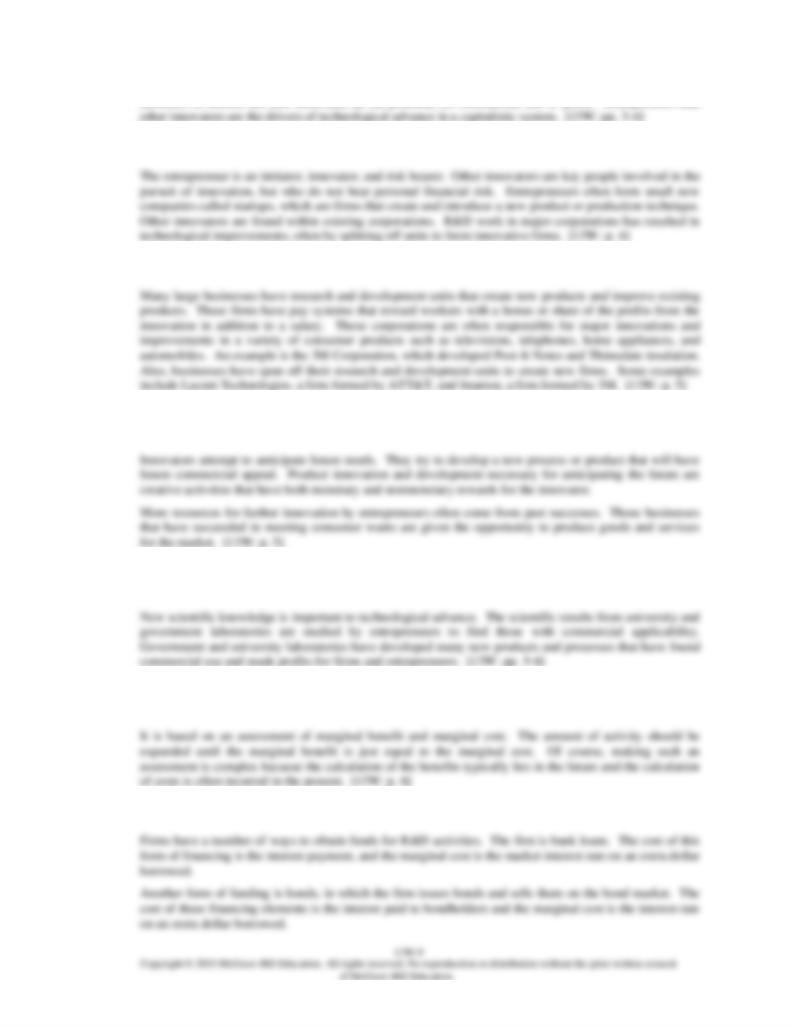
advances in science are also motivated by the potential for commercial use or profit. Entrepreneurs and
7. In what ways do entrepreneurs differ from other innovators? In what types of businesses do entrepreneurs
and innovators tend to work? How do past successes affect these types of individuals?
8. Is innovation within existing firms important? Explain and give examples.
9. What does it mean that “innovators try to anticipate the future”? What are the economics consequences of
this effort?
10. Why do entrepreneurs and other innovators actively study the scientific output of universities and
government laboratories?
11. What calculation determines the optimal amount of research and development for the firm? Why is this
decision a complex one?
12. What ways do firms have to finance R&D activities? What is the cost of these forms of funding?
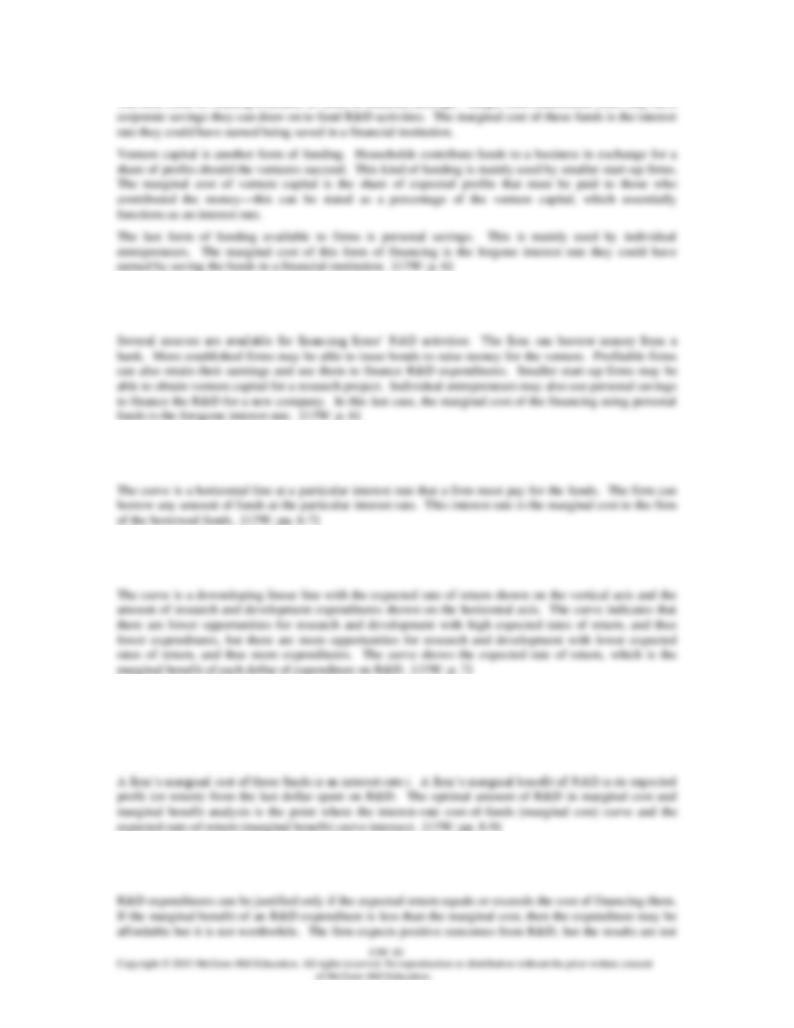
The next form of funding available to firms is retained earnings. Large, well-established firms may have
13. What are the many different sources of funding to finance firms’ R&D expenditures? If an entrepreneur
uses personal funds is there a cost for financing?
14. Describe the interest-rate cost-of-funds curve as it relates to R&D expenditures and as presented in this
chapter.
15. What is the shape of the expected-rate-of-return curve as presented in this chapter? Why does it have this
shape?
16. Explain how the firm decides on the optimal amount of research and development.
The optimal amount of research and development for the firm depends on the marginal benefit and
marginal cost of R&D activity. To earn the greatest profit, the firm will expand an activity until its
marginal benefit equals its marginal cost.
17. Why might many R&D expenditures be affordable, but not worthwhile? Are outcomes from R&D
guaranteed?
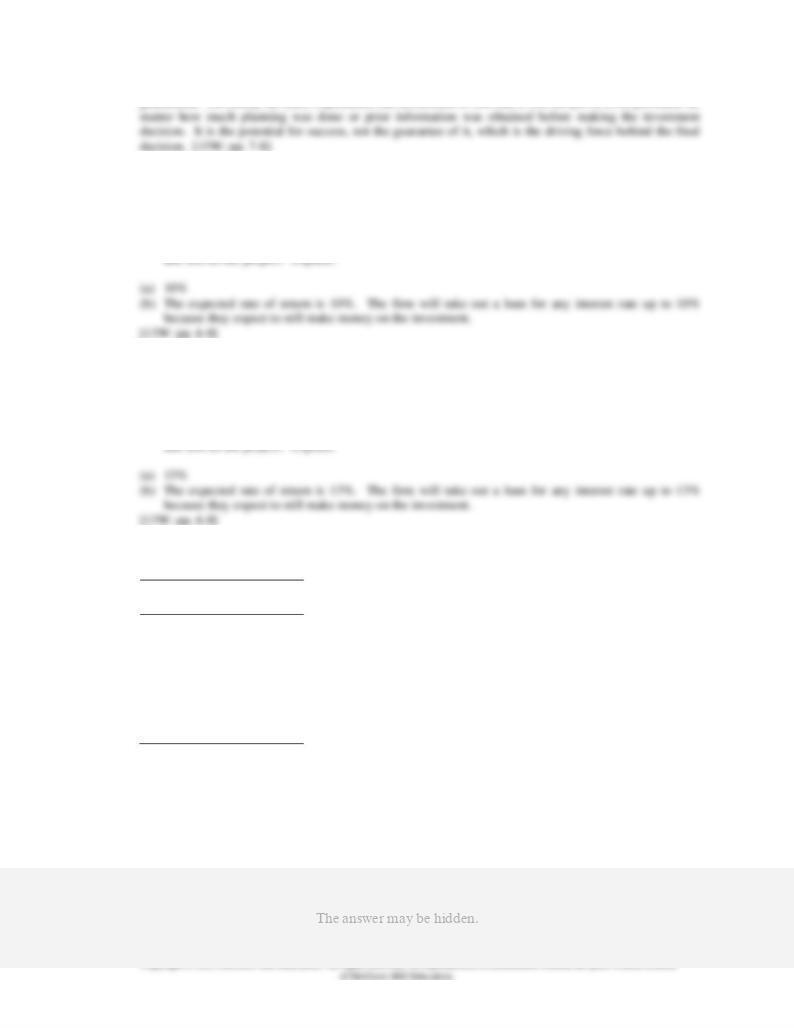
guaranteed. Obviously, an R&D expenditure has an element of risk that it will not prove to be profitable no
18. A firm decides to make a $10 million expenditure on research and development that will create a new
product. This product is expected to increase the firm’s revenues by a total of $12 million in the next year.
The firm also estimates that the production cost of the new product will be $11 million.
(a) What is the expected rate of return on this research and development expenditure?
(b) If the firm has to take out a loan to finance the project, what is the highest interest rate they will pay
19. A firm decides to make a $15 million expenditure on research and development that will create a new
product. This product is expected to increase the firm’s revenues by a total of $20 million in the next year.
The firm also estimates that the production cost of the new product will be $18 million.
(a) What is the expected rate of return on this research and development expenditure?
(b) If the firm has to take out a loan to finance the project, what is the highest interest rate they will pay
20. Use the table below that shows the rate of return and R&D spending for a hypothetical firm. Assume the
interest-rate cost of funds is 8%.
Expected rate
of return (%)
R&D
(millions of $)
14
6
12
9
10
12
8
15
6
18
4
21
2
24
(a) What is the optimal amount of R&D expenditures? At this amount, what will be the marginal cost and
what will be the marginal benefit of R&D spending?
(b) Now assume that the interest-rate cost of funds rises to 12%. What will be the optimal amount of
R&D spending? For this amount of R&D spending, what will be the marginal cost and what will be
the marginal benefit (expected rate of return)?
(c) Now assume that the interest-rate cost of funds falls to 6%. What will be the optimal amount of R&D
spending? For this amount of R&D spending, what will be the marginal cost and what will be the
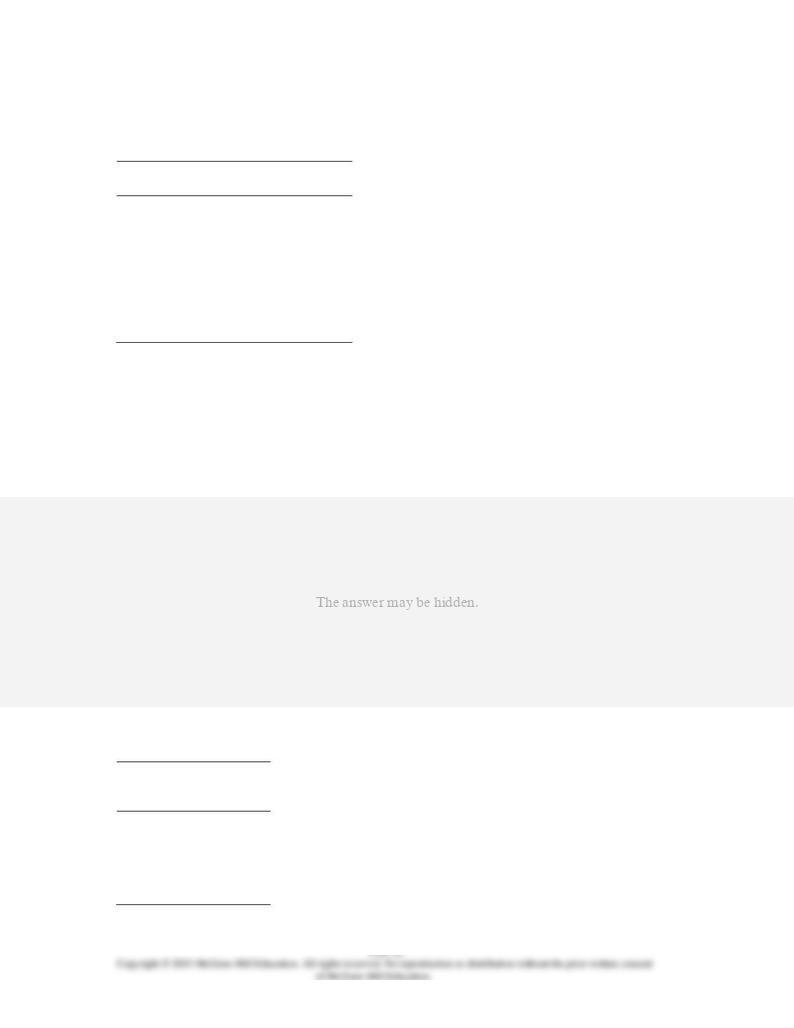
21. The initial values for expected returns, R&D and interest-rate cost for an energy company’s investment in
developing alternative fuels are listed in the table below. Using this information, answer the following
questions.
Expected rate
of return (%)
R&D
(millions)
Interest rate
cost of funds, %
40
$20
15
35
30
15
30
40
15
25
50
15
20
60
15
15
70
15
10
80
15
5
90
15
(a) What is the equilibrium level of return and R&D?
(b) Suppose that the energy company’s credit rating plummets after it is exposed for using unethical
accounting practices. How will this affect the expected-rate-of-return curve and interest-rate cost of
funds?
(c) Suppose the interest-rate cost of funds curve shifts upward by 10%. What will be the new equilibrium
rate of return and level of R & D investment?
(d) Suppose that the increased cost of oil has increased the demand for alternative fuels. How will this
affect the interest-rate cost of funds and expected return curves?
(e) Suppose the expected-rate-of-return curve shifts outward by 10%. What will be the new equilibrium
22. Use the table below that shows the rate of return and R&D spending for a hypothetical firm. Assume the
interest-rate cost of funds is 6%.
Expected rate
of return (%)
R&D
(millions of
$)
15
0
12
10
9
20
6
30
3
40
(a) Graph the marginal cost and marginal benefit curves of R&D spending in the graph below. Be sure to
label the axes. What is the optimal level of R&D spending?
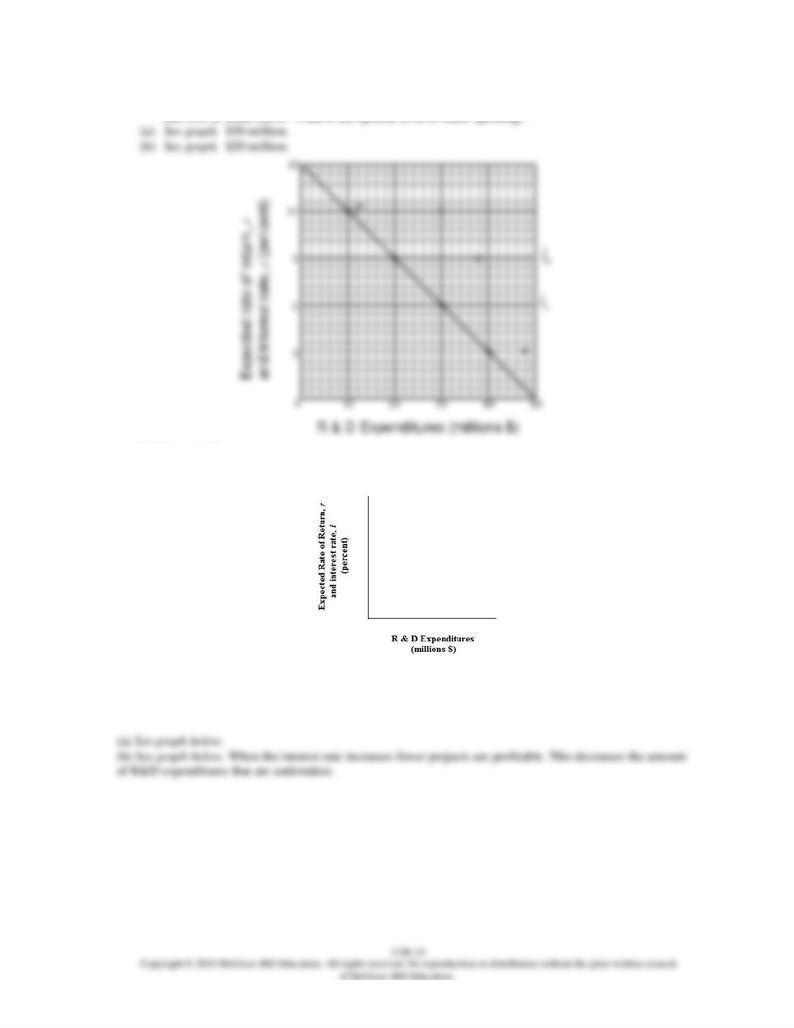
(b) Now assume that the interest-rate cost of funds is 9%. Show on the graph what happens to the interest-
23. Use the graph below to answer the following questions.
(a) Draw in a typical marginal cost and marginal benefit curve of R&D in the graph below. Suppose the
equilibrium interest rate is 5% and the R&D expenditures is 25 million.
(b) Graphically depict the effect of an increase in the interest rate from 5% to 7%. What happens to the amount
of R&D Expenditures?
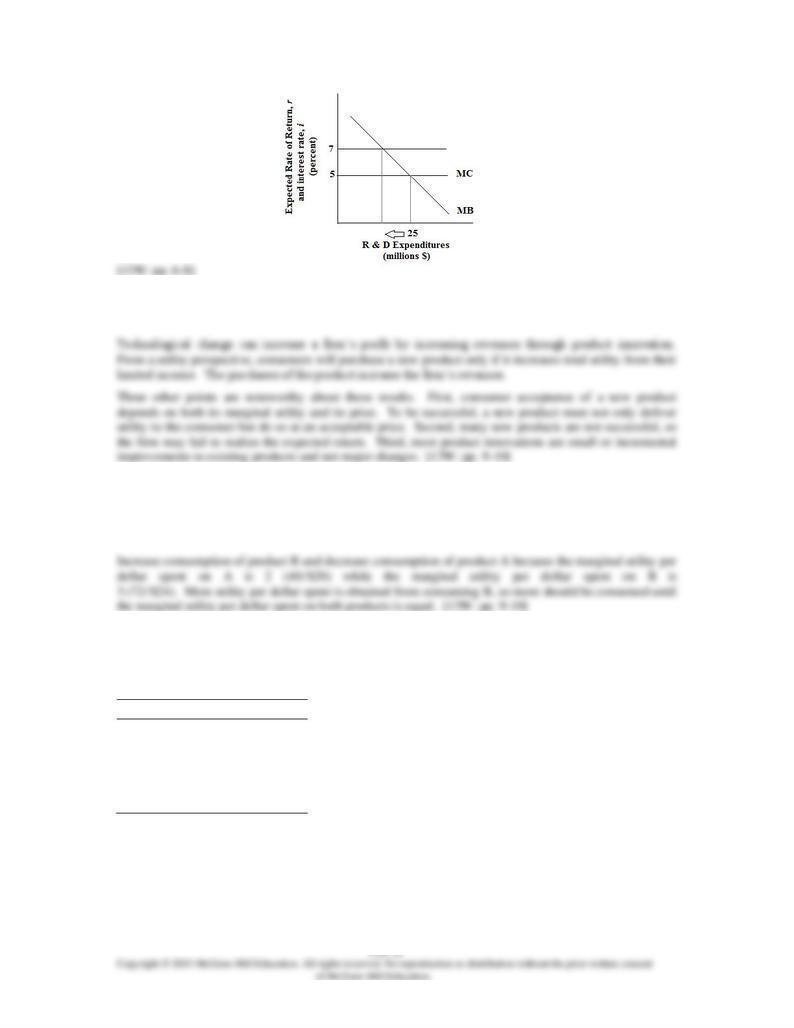
24. Describe how a firm’s revenues and profits are increased through product innovation. What three other
points should be noted about these results?
25. A consumer makes purchases of an existing product A such that the marginal utility is 40 and the price is
$20. The consumer also tries a new product B and at the current level of consumption it has a marginal
utility of 72 and a price of $24. What does the utility-maximizing rule suggest that this consumer should
do?
26. The table below shows the marginal utility schedules for old product X and new product Y for a
hypothetical consumer. The price of X is $4 and the price of good Y is $2. The income of the consumer is
$20.
Product X
Product Y
Quantity
MUx
Quantity
MUy
1
32
1
28
2
28
2
24
3
24
3
20
4
20
4
16
5
16
5
12
(a) If the consumer can only buy old product X, how much will the consumer buy and what will be the
total utility per dollar spent?
(b) If the consumer buys both old product X and new product Y, how much will the consumer buy of each
to maximize utility?
(c) If the consumer purchases the utility-maximizing combination of old product X and new product Y,
total utility will be ___________.
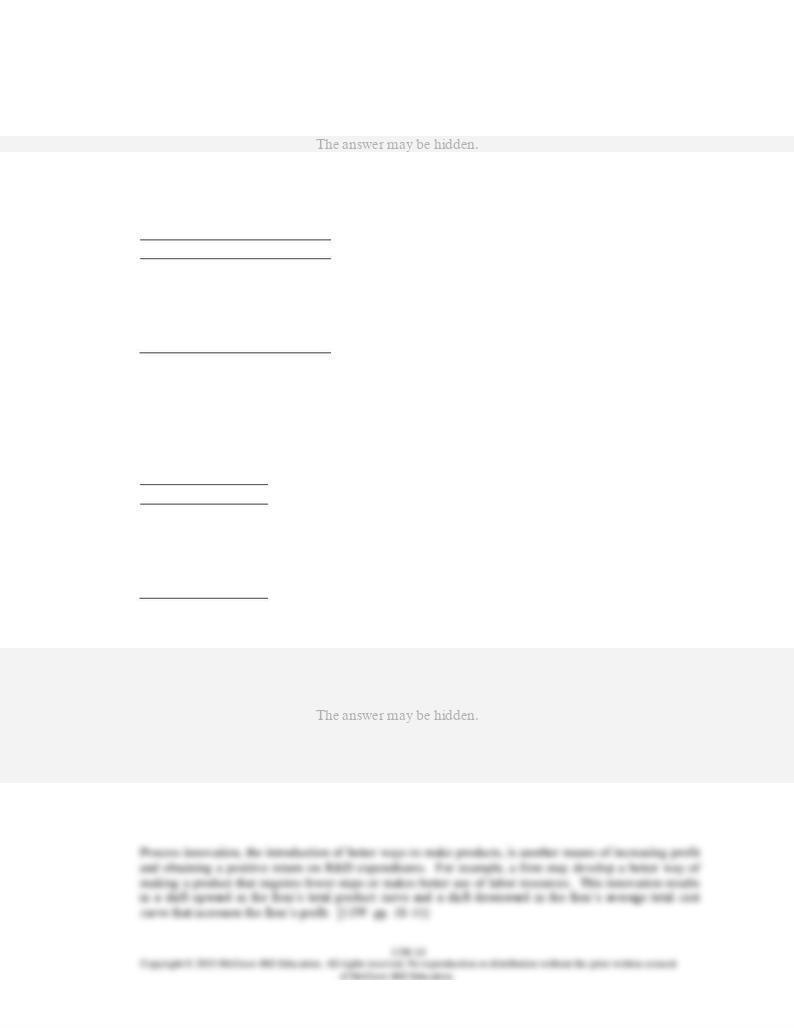
(d) The consumer was originally limited to purchasing old product X but now can also purchase new
product Y. What is the increase in total utility from the original situation when the consumer
27. The table below shows the marginal utility schedules for a soft drink (MUs) and an energy drink (MUe).
The price of the soft drink is $2 and the price of the energy drink is $4. The consumer’s income is $10.
Soft Drink
Energy Drink
Quantity
MUs
Quantity
MUe
1
50
1
70
2
40
2
50
3
30
3
40
4
20
4
24
5
10
5
20
(a) If the consumer can only buy the soft drink, how much will the consumer buy and what will be the
total utility?
(b) If the consumer buys both the soft drink and the energy drink, how much will the consumer buy to
maximize utility? How much will total utility change?
Suppose another company decides to enter the energy drink market and the marginal utility schedule for
that firm is listed below. Their energy drink is price at $3.
Energy Drink 2
Quantity
MUe2
1
50
2
40
3
30
4
20
5
10
(c) With the introduction of the new energy drink, what bundle will the consumer choose to maximize
utility? What will be the total level of utility?
28. Explain how process innovation reduces cost and increases profits. How does this innovation affect the
firm’s total product curve and average cost curve?
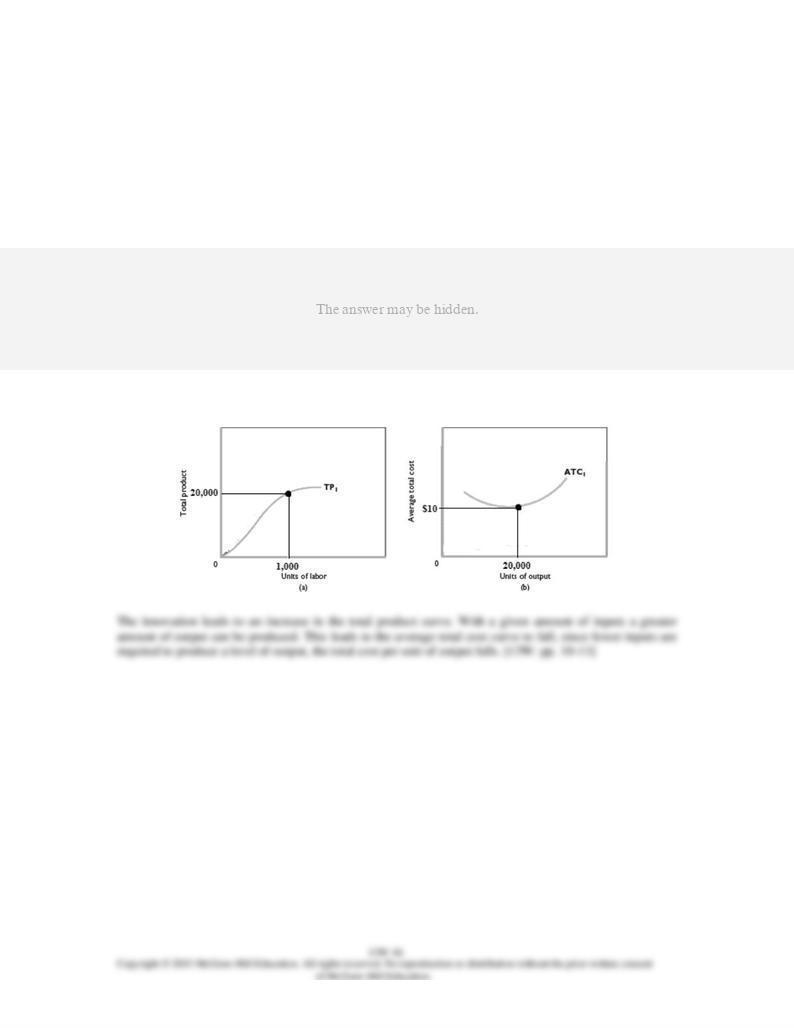
29. Assume a firm faces these costs: total cost of capital = $4000; price paid for labor = $20 per labor unit; and
price paid for raw materials = $8 per raw-material unit.
(a) If the firm can produce 2000 units of output by combining its fixed capital with 200 units of labor and
500 units of raw materials, then what are the total cost and average total cost of producing the 2000
units of output?
(b) The firm now improves its production process so that it can produce 3000 units of output by
combining its fixed capital with 100 units of labor and 500 units of raw materials. What are the total
cost and average cost of producing the 3000 units of output?
(c) Based on the data, what conclusion can you draw about the effect of process innovation on economic
30. Suppose a new process innovation occurs. On the graphs below, show graphically the effect this innovation
has on the Total Product and Average Total Cost curves.
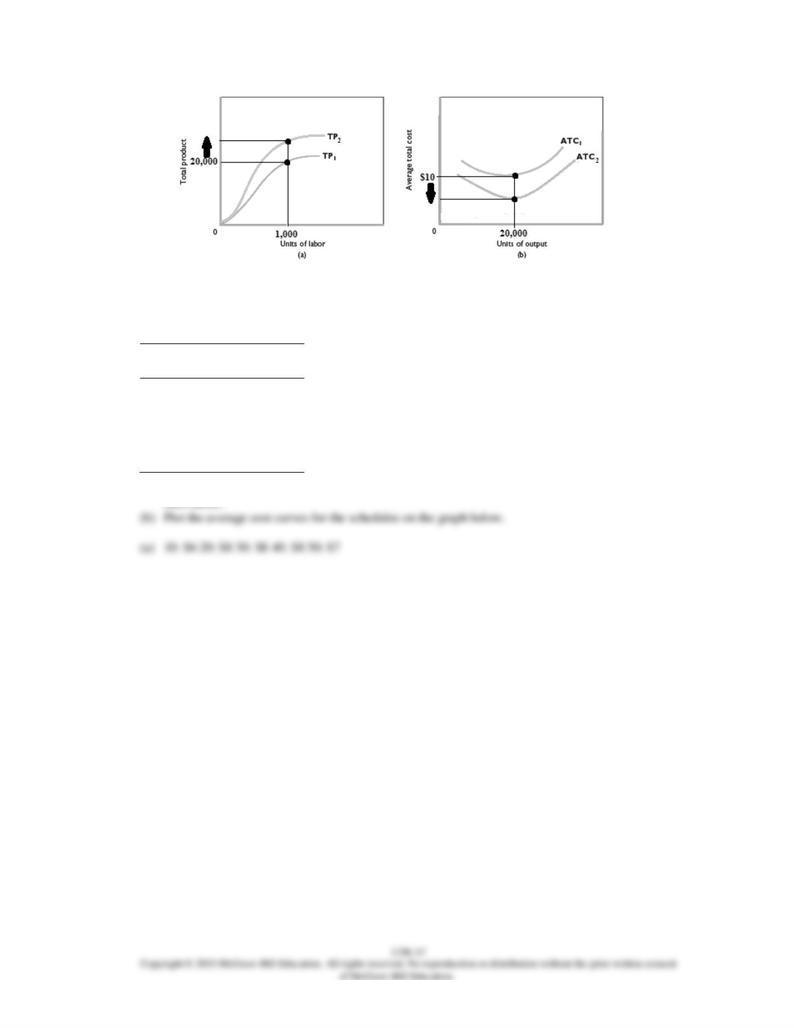
31. Below are two average total cost schedules for a firm. The first schedule (ATC1) shows the cost of
producing the product at five levels of output before a new innovation. The second schedule (ATC2) shows
the average total cost at the five output levels after the innovation. What was the reduction in average total
cost at each of the five levels of output as a result of the innovation?
Output
Before
ATC1
After
ATC2
10
$38
$32
20
30
22
30
28
20
40
31
23
50
38
31
(a) What was the reduction in average total cost at each of the five levels of output as a result of the
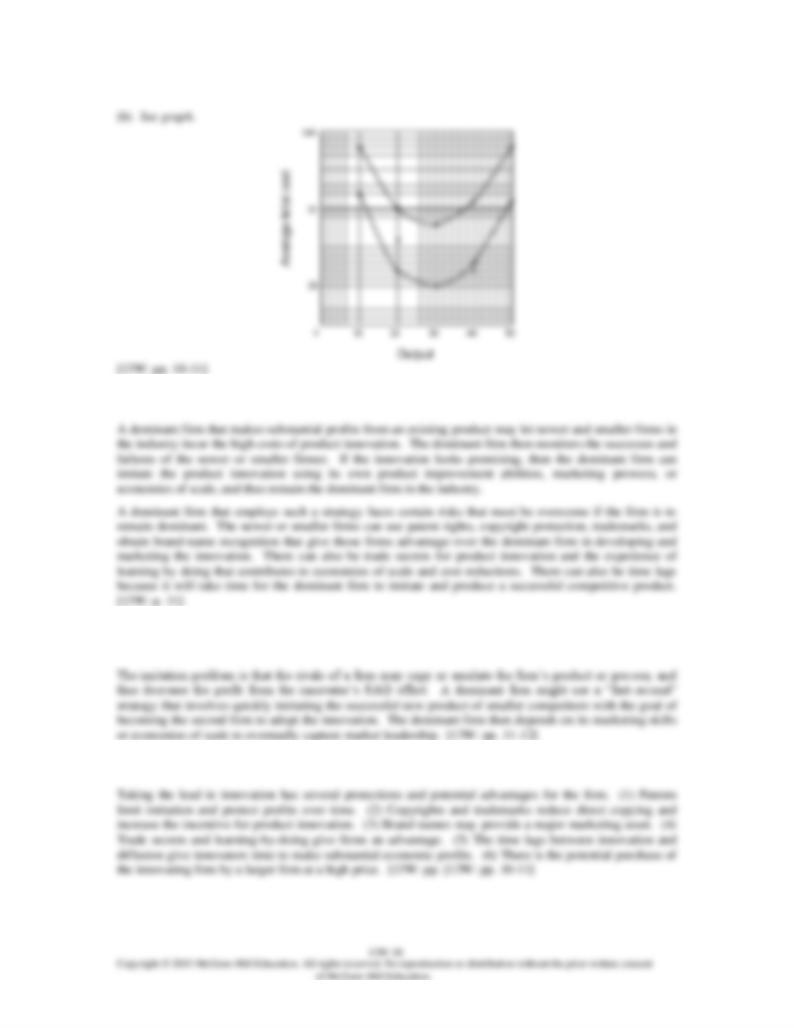
(b) See graph.
32. What is the fast-second strategy? What are the risks to a dominant firm from using such a strategy?
33. What is the imitation problem resulting from technological advance? How might a dominant firm respond
to the threat from product innovation by a smaller firm?
34. Describe the legal protections and potential advantages of taking the lead in innovation.

35. (Consider This) What product did the Roman citizen Erasmo (c. 130 A.D.) produce and how did he maintain
his trade secret?
He produced violin strings out of sheep intestines. To maintain a trade secret, he said he made the strings out
36. Compare pure competition, pure monopoly, monopolistic competition, and oligopoly for technological
advance in the form of new product development.
37. Compare and contrast the suitability of different market structure for fostering technological advance.
38. Explain the reasoning behind the inverted-U theory of R&D expenditures.
The theory suggests that R&D development is at its best with very low concentrations (pure competition)
and very high concentrations (pure monopoly). R&D compared to sales is low in the case of purely
competitive firms because the firms are relatively small in relation to the market, meaning it’s harder for
those firms to engage in R&D. R&D compared to sales is low for monopolies because profits are already
high for these firms and innovation is not likely to add much more to their profits. Moreover, innovations
will likely involve costly renovations of plants. Finally the lack of competition provides monopolies with
little incentive to innovate.
39. Explain the basic conclusions from inverted-U theory of R&D. What will be the optimal market structure
for technological progress? What does the evidence suggest about its validity?
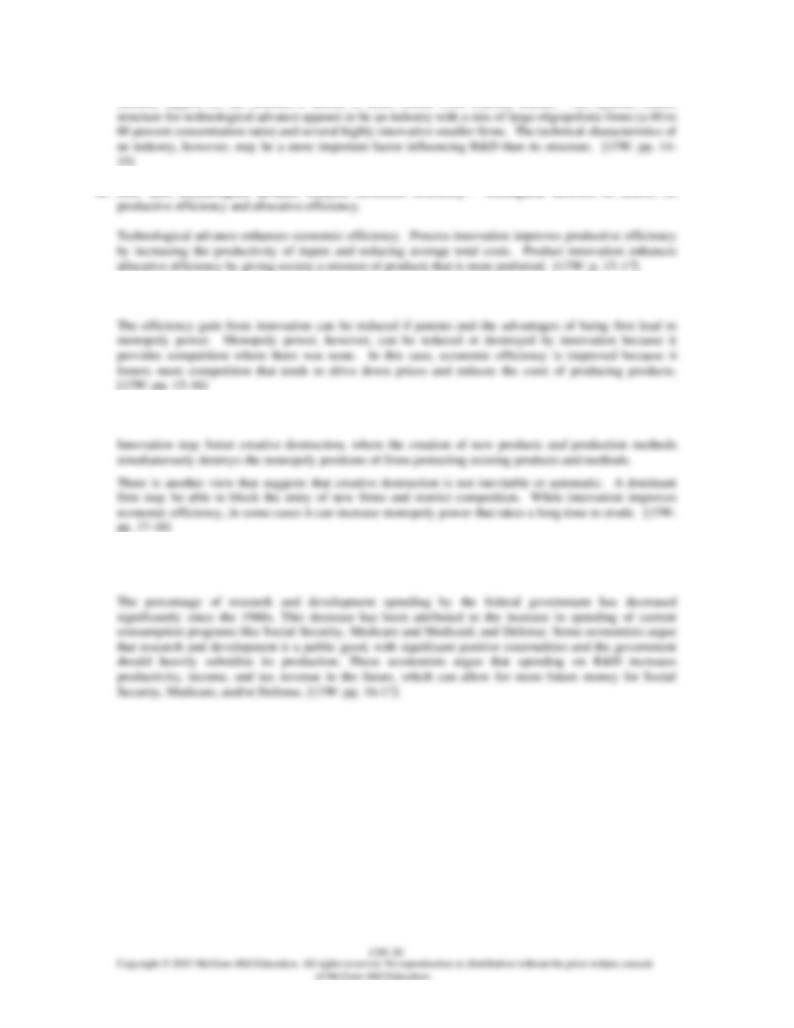
General support for the inverted-U theory of R&D comes from industry studies. The optimal market
41. How might innovation create or reduce monopoly power?
42. How can innovation foster creative destruction? What are the objections to that idea?
43. (Last Word) Evaluate this statement “We should reduce federal spending on research and development
today. Those federal dollars are better spent by helping the poor.”